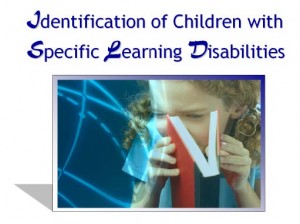 by Patricia Hozella
by Patricia Hozella
Office of Special Education Programs
U.S. Department of Education
April 2007
- English only slideshow
- Handouts for Participants in both English and Spanish
Module 11 looks closely at the process by which schools identify that a child has a specific learning disability (LD). While all of the requirements discussed in Modules 9 and 10 also apply to evaluating a child for the presence of LD, there are many additional requirements in identifying a learning disability–with many significant changes brought about by IDEA 2004.
Module 11 is available in English only (except for the handouts for participants, which are also available in Spanish). The module includes:
- a slideshow presentation;
- a Trainer’s Guide; and
- handouts for participants in both English and in Spanish.
Please help yourself below, and download the components you need to learn on your own and/or to train others regarding how LD is identified under IDEA 2004.
Back to top
___________________
Component #1: The Slideshow
English only
Use these 33 full-color slides to learn about and train others on what IDEA requires as a process for identifying a specific learning disability.
- Slideshow for Module 11 (in a ZIP folder)
Component #2: Trainer’s Guide to the Content
The Trainer’s Guide illustrates how each slide operates and provides detailed discussion of the content on each slide. It’s available in both a nicely laid-out PDF file with thumbnail graphics of the slides and as an accessible Word file (from which you can freely copy and paste content to other documents). Which would you like?
Word | Complete Guide (Accessible Word file)
Component #3: Handouts for Participants | Folletos para Participantes
In English and in Spanish
The handouts for Module 11 are included in a packet of handouts designed to cover the entire umbrella topic of Theme C, Evaluating Children for Disability. If you’ve downloaded the handouts for Theme C already (for example, as part of training on Modules 9 or 10), you have the handouts you need for Module 11. If you haven’t downloaded any handouts for Theme C yet, here they are in 2 different formats and 2 different languages.
Handouts in English
PDF | English Handouts for Theme C
Word | English Handouts for Theme C (Accessible Word file)
Handouts in Spanish | Folletos en Español **
Word | Los Folletos para la Tema C (en archivo accesible)
Note about the Spanish Translations:
In preparing the handouts in Spanish, we chose to use a certain vocabulary set for the terminology most frequently used in IDEA. IDEA itself is extremely and purposefully consistent about its terminology, and we felt it critical to do the same in Spanish. However, we fully recognize that there are many ways to say the same thing, and Spanish is rich with alternatives from country to country, region to region. So we’ve also prepared a glossary of the terminology used in IDEA, how we’ve rendered that terminology in Spanish, and other ways of rendering it that families may also hear. Share this with participants as you see fit or use it to guide your own translations. The glossary of terminology is available in two formats, PDF and Word:
There! You’re all set to go for Module 11.
Please remember that these materials are designed to be a thorough and authoritative source of info on how a learning disability is to be identified under IDEA 2004. That’s why they are so detailed. As a trainer, you are free to adapt the info we’ve offered to serve the purposes and needs of your audiences and the amount of time you have to spend with them.
______________________________
Quick-Jump Menu to Other Modules
1: Top 10 Basics of Special Education
2: Key Changes in IDEA
5: Disproportionality and Overrepresentation
6: Early Intervening Services and Response to Intervention
7: Highly Qualified Teachers (withdrawn with the reauthorization of NCLB as the ESSA in 2015)
8: NIMAS
9: Introduction to Evaluation under IDEA
10: Initial Evaluation and Reevaluation
11: Identification of Children with Specific Learning Disabilities (you’re already here)
12: The IEP Team
13: Content of the IEP
14: Meetings of the IEP Team
15: LRE Decision Making
16: Children Enrolled by Their Parents in Private Schools
17: Introduction to Procedural Safeguards
18: Options for Dispute Resolution
19: Key Issues in Discipline

